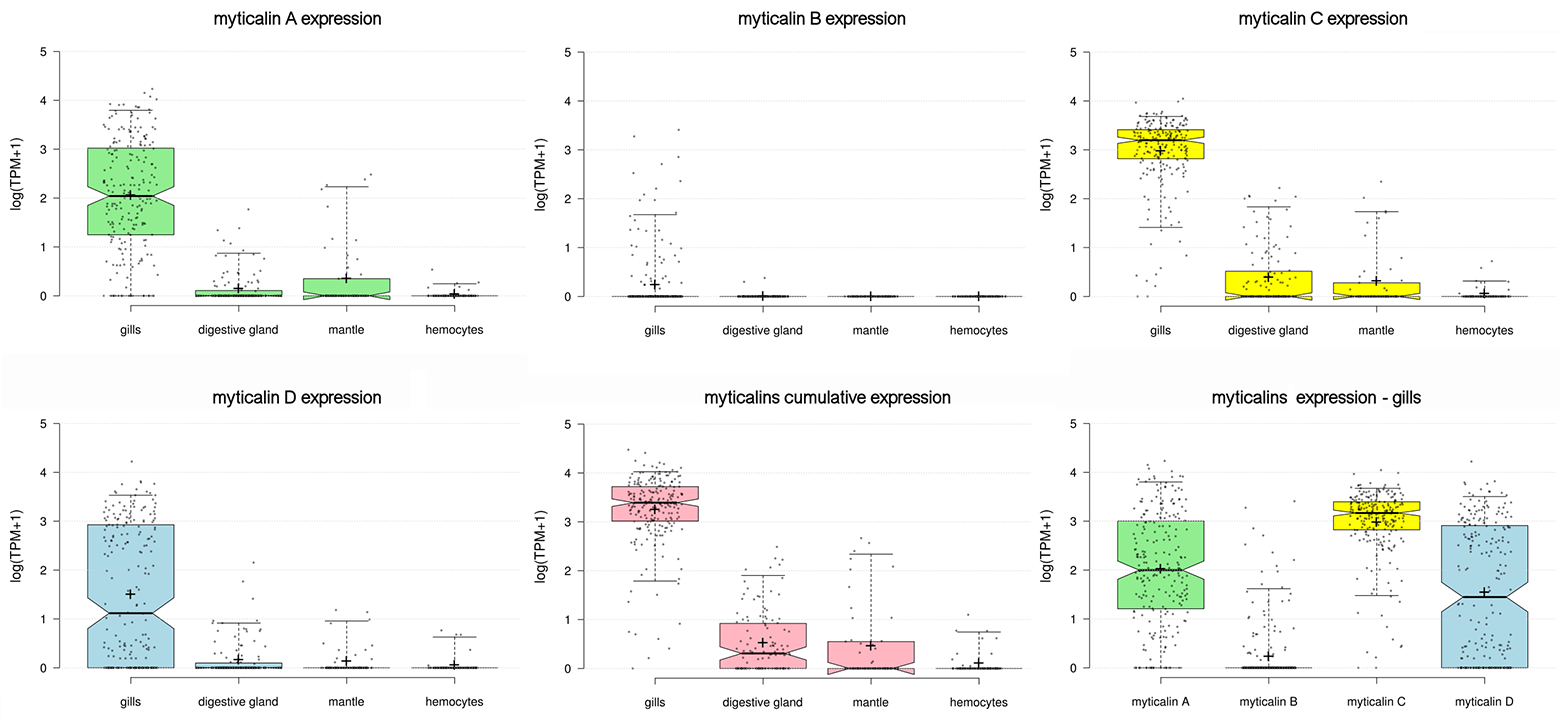Myticalins (an acronym for Mytilus cationic linear antimicrobial peptides) are a family of antimicrobial peptides involved in innate immune defense in marine mussels belonging to the Mytilus genus, first described by Leoni and colleagues in 2017. The mode of action of these AMPs has been further explored in 2021 by Pacor and colleagues, whereas an updated analysis of available genomic data for the different species belonging to the Mytilus complex and the creation of a comprehensive sequence collection of myticalin variants led to the establishment of the present database in 2025.
Myticalins are produced as pre-propeptides, displaying a tripartite organization with a N-terminal signal peptide, a central highly cationic mature region, and a C-terminal anionic extension, which is cleaved upon the recognition of a dibasic (KR) cleavage site.
Although mussels produce a plethora of different antimicrobial peptides, most of them are characterized by the presence of complex structures, stabilized by multiple disulfide bonds, as in the case of defensins, mytilins and myticins. Myticalins on the other hand are devoid of cysteine residues, being therefore linear and display highly biased amino acid compositions, which determine their classification within five subfamilies, i.e. A, B, C, D and E. In myticalin phylogeny, these five subfamilies represent highly supported monophyletic groups, each of which is characterized by the enrichment of particular amino acid residues within the mature peptide region.
Another unique distinctive feature of myticalins concerns their strong tissue specificity to the gills, which marks a striking difference compared with mussel cysteine-rich AMPs, which are typically expressed in hemocytes.
Leoni et al. 2017, Marine Drugs - Myticalins: A Novel Multigenic Family of Linear, Cationic Antimicrobial Peptides from Marine Mussels (Mytilus spp.).
https://doi.org/10.3390/md15080261
Pacor et al. 2021, Peptides - The proline-rich myticalins from Mytilus galloprovincialis display a membrane-permeabilizing antimicrobial mode of action.
https://doi.org/10.1016/j.peptides.2021.170594
Kireta et al. under review - MyticalinDB: expanding the landscape of a hyperdiverse, gill-specific family of antimicrobial peptides in Mytilus spp.
Okimura et al. 2021, Biological and Pharmaceutical Bulletin - Examination of the Antimicrobial Peptide Myticalin A6 Active Site.
https://doi.org/10.1248/bpb.b20-00799
Liu et al. 2022, Acta Hydrobiologica Sinica - Molecular characterization of two novel antimicrobial peptides myticalin and mytimacin from Mytilus coruscus.
https://doi.org/10.7541/2022.2021.0392
Aniket and Sudha, 2024, Probiotics and Antimicrobial Proteins - Novel antimicrobial peptide SAAP mutant as a better adjuvant to sulbactam-based treatments against clinical strains of XDR Acinetobacter baumannii.
https://doi.org/10.1007/s12602-023-10067-5
We acknowledge financial support under the National Recovery and Resilience Plan (NRRP), Mission 4, Component 2, Investment 1.1, Calls for tender No.: 104 published on 2.2.2022 by the Italian Ministry of University and Research (MUR), funded by the European Union – NextGenerationEU– Project Title Prot. 2022ZRZBZ7 - IMPAVID - Exploring the impact of gene presence-absence variation on mussel reproductive fitness and larval survival – CUP J53D23006830001 - Grant Assignment Decree No. n. 1015 adopted on 07/07/2023 by the Italian Ministry of Ministry of University and Research (MUR); No. 1409 published on 14.9.2022 by the Italian Ministry of University and Research (MUR), funded by the European Union – NextGenerationEU– Project Title Prot. P2022JEEMT - Developing a tool for the study of haplotype diversity in Mytilus galloprovincialis (HAMIGA) – CUP J53D23013780001 - Grant Assignment Decree No. 1370 adopted on 01/09/2023 by the Italian Ministry of Ministry of University and Research (MUR).






